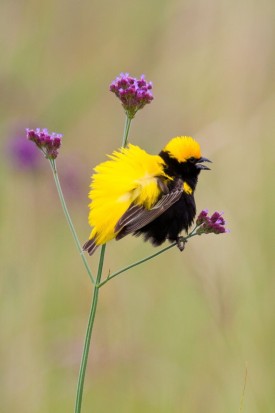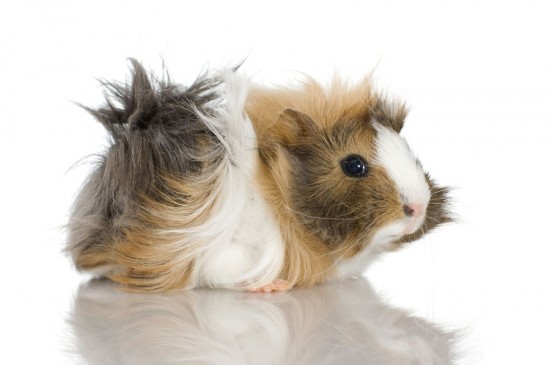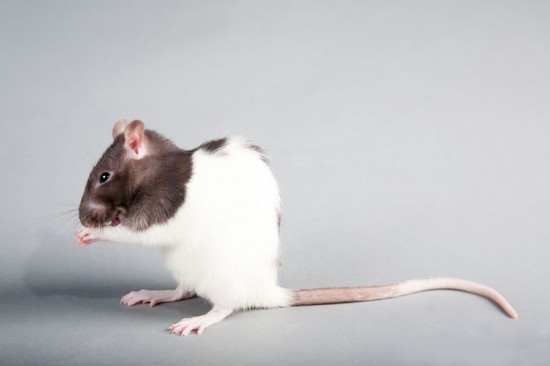

The Napoleon Weaver (Euplectes afer) is more correctly known as the Yellow Crowned Bishop and is a member of the Ploceidae family of African weavers. During breeding season, the male birds are brightly colours with brilliant yellow and black plumage while outside breeding season, the male and female are much the same. The Napoleon Weaver is 9.5-13cm in length depending on sub-species and weigh around 15 grams.
Their native habitats is the grassland, vlies and pans across much of Africa as well as having been introduced to Jamaica, Japan, Portugal, Puerto Rico and Venezuela as well as a colony in Florida. They are often found to live in wheat and sorghum fields as well as the weedy vegetation at the edges of wetlands.
In the wild, these weavers will be found in flocks with other weavers and sparrows outside breeding condition but separate into families during breeding season.
When not breeding, these birds happily live in a mixed aviary with other birds of various sorts. When they come around to breeding time, the male can be defensive of his nests so needs to be monitored, especially if there are smaller birds in the enclosure. The problems mainly occur if the aviary is overcrowded or if there aren’t enough plants to make them feel safe and comfortable. It is best to avoid keeping them with any other species of weaver as during breeding season, fights can occur.
These birds are definitely aviary birds and the larger the enclosure the better, though a large indoor aviary can be sufficient. As mentioned, they need a well-planted aviary and plants such as bamboo, corn and reeds are amongst the best for them. They are hardy birds that can manage in winter outside as long as they have a well-sheltered and frost-free night house.
Napoleon Weavers are very active birds that make use of all of the aviary and are also keen to bathe so access to fresh water is important. They are not birds that become tame and will generally avoid their keepers.
The wild diet of these birds is insects, grains and seeds of the plants they live around. In captivity, this translates to a seed mixture for tropical birds with the frequent addition of insect paste and live insects. They will also eat fruit such as apples, egg woods, weeds and half-ripe grass seeds. Always have grit available for them to use as required.
These birds are polygamous, so the male bird will often have two or more mates. He builds a number of oval nests that have a top opening where he displays to attract the females. The nests are made from the stems of the grasses or sedges they live amongst as well as parts from shrubs where the female lays 2-4 eggs. Incubation is done by the female for 12-14 days and the chicks fledge at 11-13 days. They are fully independent by five weeks of age.
Breeding in captivity follows a similar pattern. The nests are built in shrubs, using reeds, corn or bamboo to attach them to if you have them. At this point, they will need spiders, fruit flies and mealworms to feed the young and will vigilantly defend the territory around their nest. When the young have fledged, they can live with their parents for some time until the young males begin to show breeding plumage at which time they will need to be removed to avoid conflict.
There are many other species in the weaver family, but of these, the other two that are most often found in aviculture in this country are the Northern Red Bishop and the Southern Red Bishop.
The Northern Red Bishop (Euplectes franciscanus) comes from the southern half of Africa and when in breeding plumage, has a black head, brilliant orange throat and chest, black belly then orange edged black wings and tail and an orange rump. As with all weavers, outside breeding season he resembled his hen. Some of the subspecies are more red than orange in the breeding colours.
In the wild, they live in open country with tall grassland and near water across Africa south of the Sahara Desert and north of the Equator. They have also been introduced to Puerto Rico, Martinique and Guadeloupe.
The Southern Red Bishop (Euplectes orix) is found south of the Equator in Africa in wetlands and grasslands. It is slightly smaller than the Northern Red Bishop and its breeding plumage is red or orange but with different patterns. The face is black while the rest of the head is orange, the breast is black, the rump and back is orange and the wings are orange edged black, as is the tail. Therefore, the two species can be told apart by eyesight alone with the males in breeding condition.
Both of these species are similar to the Napoleon Weaver in both feeding and breeding patterns and their behaviour in the aviary is also similar. While they will mix well with others when they are not breeding, they can be defensive of their nests when they are breeding and they also need to have more than one hen each to avoid problems. The males can be very enthusiastic with their mates so this is always the best policy.
Despite being from Africa, both species can adapt to being outside relatively easily but do need a sheltered night house that is frost free to keep them from being exposed to the worst of the cold.
None of these birds are commonly found in aviculture in this country but that isn’t to say it is impossible to get them. At the moment, the Napoleon seems to be the most common of the three and if a suitable group is purchased they can be bred, though are not perhaps the best birds to start up with. This is mostly due to their potential for aggression during breeding season and over enthusiasm with their hens meaning they need a careful eye to avoid any problems.
 Popular Guinea Pig Breeds
Popular Guinea Pi
Popular Guinea Pig Breeds
Popular Guinea Pi
 Common Health Problems Of Pet Rats
Common Health Pro
Common Health Problems Of Pet Rats
Common Health Pro
 From Bow Bow To Wow Wow!
From Bow Bow To Wow Wow!
Caring for your pets
From Bow Bow To Wow Wow!
From Bow Bow To Wow Wow!
Caring for your pets
 Treatment Options For Hip Dysplasia In Dogs
Treatment Options
Treatment Options For Hip Dysplasia In Dogs
Treatment Options
 Cucak Hijau / Murai Daun
Cucak Hijau (Chloropsis sonnerati) atau biasa j
Cucak Hijau / Murai Daun
Cucak Hijau (Chloropsis sonnerati) atau biasa j
Copyright © 2005-2016 Pet Information All Rights Reserved
Contact us: www162date@outlook.com